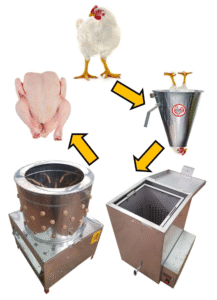
Broiler processing in Nigeria is a growing sector with huge potential due to the country’s increasing population, urbanization, and rising demand for affordable animal protein. However, to succeed in this business, you need to understand the market dynamics, infrastructure requirements, regulations, and challenges. Below is a detailed guide on what you need to know:
1. Understanding Broiler Processing
Broiler processing involves converting live chickens into consumable meat products through slaughtering, defeathering, evisceration, chilling, and packaging.
There are two major scales of broiler processing in Nigeria:
Small-scale (manual): 100–500 birds/day, suitable for local markets.
Medium to large-scale (semi-automated/automated): 1,000–10,000+ birds/day, targeting supermarkets, restaurants, and export.
2. Key Stages in Broiler Processing
Here are the basic steps involved in broiler processing:
Step 1: Slaughtering
Birds are stunned (electrical or manual) to reduce pain and stress.
Proper halal slaughter practices must be followed for religious compliance.
Blood is drained completely for hygiene and quality.
Step 2: Scalding and Plucking
Birds are immersed in hot water (50–60°C) to loosen feathers.
Feathers are removed using automatic pluckers or manually with knives.
Step 3: Evisceration
Removal of internal organs like intestines, liver, gizzard, and heart.
These organs are either discarded or processed separately (e.g., gizzards sold separately).
Step 4: Washing and Chilling
Birds are washed thoroughly to remove blood and bacteria.
Chilled in cold water or ice baths to bring temperature down to below 4°C to prevent bacterial growth.
Step 5: Cutting and Packaging
Birds can be sold whole, cut-up, or processed into parts like wings, thighs, or fillets.
Vacuum sealing or polythene packaging is used for preservation.
Step 6: Storage
Finished products must be stored in freezers at -18°C or below.
Cold chain integrity is crucial to prevent spoilage.
3. Equipment Needed
The equipment required depends on the scale of operation.
Small-Scale (100–500 birds/day)
Killing cones – ₦50,000 – ₦150,000
Scalding tank – ₦150,000 – ₦400,000
Feather plucker – ₦300,000 – ₦700,000
Stainless steel evisceration table – ₦100,000 – ₦250,000
Water hose and sprayer
Chest freezer – ₦300,000 – ₦600,000
Estimated startup cost: ₦2M – ₦5M
Medium/Large Scale (1,000–10,000 birds/day)
Automated slaughter line – ₦8M – ₦25M+
Large scalding and plucking machine – ₦2M – ₦8M
Evisceration equipment – ₦5M – ₦15M
Blast freezer – ₦10M – ₦30M
Cold rooms – ₦15M – ₦50M
Packaging machine – ₦2M – ₦6M
Backup generator (50–100kVA) – ₦8M – ₦20M
Estimated startup cost: ₦50M – ₦150M+
4. Regulatory Requirements
Broiler processing is highly regulated for food safety. You must comply with the following:
NAFDAC Registration – for processed poultry products.
SON Standards – compliance with Nigerian Industrial Standards (NIS).
Environmental Approval – from NESREA or state environmental agencies.
Meat Inspection Certificate – issued by veterinary officers for each batch.
Halal Certification – if targeting Muslim markets (especially Northern Nigeria and export).
5. Market Opportunities
Nigeria’s poultry industry is valued at ₦1.6 trillion+ annually, with demand outpacing supply.
Target Markets:
Restaurants and fast-food chains (Chicken Republic, KFC, Tantalizers, etc.).
Supermarkets and modern retail stores (Shoprite, Spar, Justrite).
Frozen food distributors and cold-room operators.
Hotels and catering businesses.
Export to ECOWAS countries.
6. Profitability Analysis (Example: Small-Scale 500 Birds/Day)
| Item | Cost (₦) |
|---|---|
| Average live bird price | 4,500 |
| Processing cost per bird (labour, utilities, packaging) | 800 |
| Total cost per bird | 5,300 |
| Average selling price (processed & packaged) | 6,500 |
| Profit per bird | 1,200 |
Daily profit:
500 birds × 1,200 = ₦600,000
Monthly profit (25 working days): ≈ ₦15M
7. Challenges in Nigeria
While lucrative, the business comes with some challenges:
| Challenge | Mitigation |
|---|---|
| Power supply issues – frequent outages affect cold rooms. | Invest in generators or solar backup. |
| High cost of feed and live birds | Backward integration – operate your own poultry farm. |
| Regulatory bottlenecks | Work closely with local veterinary and health authorities. |
| Logistics and cold chain management | Use reliable refrigerated vans and cold storage partners. |
| Market competition | Focus on branding, hygiene, and premium quality packaging. |
8. Tips for Success
Build relationships with large poultry farms for consistent live bird supply.
Invest in branding and marketing – clean, attractive packaging wins customers.
Ensure strict hygiene standards to avoid contamination and food safety issues.
Start small, then scale up as demand grows.
Leverage technology – use POS systems and track inventory digitally.
Consider value-added products like chicken sausages, nuggets, or smoked chicken for higher margins.
9. Estimated Startup Costs
| Scale | Bird Capacity/Day | Capital Required (₦) |
|---|---|---|
| Small-scale | 100–500 | 2M – 5M |
| Medium-scale | 1,000 – 3,000 | 15M – 50M |
| Large-scale | 5,000 – 10,000+ | 50M – 150M+ |
10. Conclusion
Broiler processing in Nigeria is highly profitable due to rising demand for frozen chicken and the government’s restrictions on poultry imports. However, success depends on:
Investing in proper equipment and infrastructure,
Maintaining strict hygiene and regulatory compliance,
Building reliable cold chain and distribution networks,
Offering consistent quality to gain customer trust.
